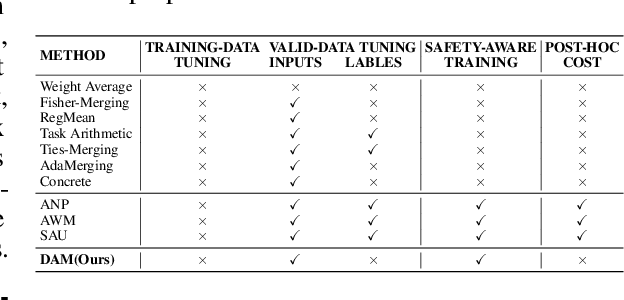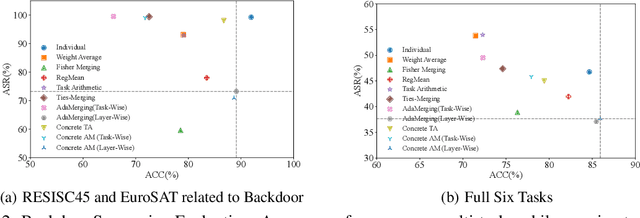Jinluan Yang
Noise Projection: Closing the Prompt-Agnostic Gap Behind Text-to-Image Misalignment in Diffusion Models
Oct 16, 2025Abstract:In text-to-image generation, different initial noises induce distinct denoising paths with a pretrained Stable Diffusion (SD) model. While this pattern could output diverse images, some of them may fail to align well with the prompt. Existing methods alleviate this issue either by altering the denoising dynamics or by drawing multiple noises and conducting post-selection. In this paper, we attribute the misalignment to a training-inference mismatch: during training, prompt-conditioned noises lie in a prompt-specific subset of the latent space, whereas at inference the noise is drawn from a prompt-agnostic Gaussian prior. To close this gap, we propose a noise projector that applies text-conditioned refinement to the initial noise before denoising. Conditioned on the prompt embedding, it maps the noise to a prompt-aware counterpart that better matches the distribution observed during SD training, without modifying the SD model. Our framework consists of these steps: we first sample some noises and obtain token-level feedback for their corresponding images from a vision-language model (VLM), then distill these signals into a reward model, and finally optimize the noise projector via a quasi-direct preference optimization. Our design has two benefits: (i) it requires no reference images or handcrafted priors, and (ii) it incurs small inference cost, replacing multi-sample selection with a single forward pass. Extensive experiments further show that our prompt-aware noise projection improves text-image alignment across diverse prompts.
AdaR1: From Long-CoT to Hybrid-CoT via Bi-Level Adaptive Reasoning Optimization
Apr 30, 2025



Abstract:Recently, long-thought reasoning models achieve strong performance on complex reasoning tasks, but often incur substantial inference overhead, making efficiency a critical concern. Our empirical analysis reveals that the benefit of using Long-CoT varies across problems: while some problems require elaborate reasoning, others show no improvement, or even degraded accuracy. This motivates adaptive reasoning strategies that tailor reasoning depth to the input. However, prior work primarily reduces redundancy within long reasoning paths, limiting exploration of more efficient strategies beyond the Long-CoT paradigm. To address this, we propose a novel two-stage framework for adaptive and efficient reasoning. First, we construct a hybrid reasoning model by merging long and short CoT models to enable diverse reasoning styles. Second, we apply bi-level preference training to guide the model to select suitable reasoning styles (group-level), and prefer concise and correct reasoning within each style group (instance-level). Experiments demonstrate that our method significantly reduces inference costs compared to other baseline approaches, while maintaining performance. Notably, on five mathematical datasets, the average length of reasoning is reduced by more than 50%, highlighting the potential of adaptive strategies to optimize reasoning efficiency in large language models. Our code is coming soon at https://github.com/StarDewXXX/AdaR1
Mix Data or Merge Models? Balancing the Helpfulness, Honesty, and Harmlessness of Large Language Model via Model Merging
Feb 13, 2025Abstract:Achieving balanced alignment of large language models (LLMs) in terms of Helpfulness, Honesty, and Harmlessness (3H optimization) constitutes a cornerstone of responsible AI, with existing methods like data mixture strategies facing limitations including reliance on expert knowledge and conflicting optimization signals. While model merging offers a promising alternative by integrating specialized models, its potential for 3H optimization remains underexplored. This paper establishes the first comprehensive benchmark for model merging in 3H-aligned LLMs, systematically evaluating 15 methods (12 training-free merging and 3 data mixture techniques) across 10 datasets associated with 5 annotation dimensions, 2 LLM families, and 2 training paradigms. Our analysis reveals three pivotal insights: (i) previously overlooked collaborative/conflicting relationships among 3H dimensions, (ii) the consistent superiority of model merging over data mixture approaches in balancing alignment trade-offs, and (iii) the critical role of parameter-level conflict resolution through redundant component pruning and outlier mitigation. Building on these findings, we propose R-TSVM, a Reweighting-enhanced Task Singular Vector Merging method that incorporates outlier-aware parameter weighting and sparsity-adaptive rank selection strategies adapted to the heavy-tailed parameter distribution and sparsity for LLMs, further improving LLM alignment across multiple evaluations. We release our trained models for further exploration.
Mitigating the Backdoor Effect for Multi-Task Model Merging via Safety-Aware Subspace
Oct 17, 2024



Abstract:Model merging has gained significant attention as a cost-effective approach to integrate multiple single-task fine-tuned models into a unified one that can perform well on multiple tasks. However, existing model merging techniques primarily focus on resolving conflicts between task-specific models, they often overlook potential security threats, particularly the risk of backdoor attacks in the open-source model ecosystem. In this paper, we first investigate the vulnerabilities of existing model merging methods to backdoor attacks, identifying two critical challenges: backdoor succession and backdoor transfer. To address these issues, we propose a novel Defense-Aware Merging (DAM) approach that simultaneously mitigates task interference and backdoor vulnerabilities. Specifically, DAM employs a meta-learning-based optimization method with dual masks to identify a shared and safety-aware subspace for model merging. These masks are alternately optimized: the Task-Shared mask identifies common beneficial parameters across tasks, aiming to preserve task-specific knowledge while reducing interference, while the Backdoor-Detection mask isolates potentially harmful parameters to neutralize security threats. This dual-mask design allows us to carefully balance the preservation of useful knowledge and the removal of potential vulnerabilities. Compared to existing merging methods, DAM achieves a more favorable balance between performance and security, reducing the attack success rate by 2-10 percentage points while sacrificing only about 1% in accuracy. Furthermore, DAM exhibits robust performance and broad applicability across various types of backdoor attacks and the number of compromised models involved in the merging process. We will release the codes and models soon.
Leveraging Invariant Principle for Heterophilic Graph Structure Distribution Shifts
Aug 18, 2024



Abstract:Heterophilic Graph Neural Networks (HGNNs) have shown promising results for semi-supervised learning tasks on graphs. Notably, most real-world heterophilic graphs are composed of a mixture of nodes with different neighbor patterns, exhibiting local node-level homophilic and heterophilic structures. However, existing works are only devoted to designing better HGNN backbones or architectures for node classification tasks on heterophilic and homophilic graph benchmarks simultaneously, and their analyses of HGNN performance with respect to nodes are only based on the determined data distribution without exploring the effect caused by this structural difference between training and testing nodes. How to learn invariant node representations on heterophilic graphs to handle this structure difference or distribution shifts remains unexplored. In this paper, we first discuss the limitations of previous graph-based invariant learning methods from the perspective of data augmentation. Then, we propose \textbf{HEI}, a framework capable of generating invariant node representations through incorporating heterophily information to infer latent environments without augmentation, which are then used for invariant prediction, under heterophilic graph structure distribution shifts. We theoretically show that our proposed method can achieve guaranteed performance under heterophilic graph structure distribution shifts. Extensive experiments on various benchmarks and backbones can also demonstrate the effectiveness of our method compared with existing state-of-the-art baselines.
Learning to Reweight for Graph Neural Network
Dec 19, 2023



Abstract:Graph Neural Networks (GNNs) show promising results for graph tasks. However, existing GNNs' generalization ability will degrade when there exist distribution shifts between testing and training graph data. The cardinal impetus underlying the severe degeneration is that the GNNs are architected predicated upon the I.I.D assumptions. In such a setting, GNNs are inclined to leverage imperceptible statistical correlations subsisting in the training set to predict, albeit it is a spurious correlation. In this paper, we study the problem of the generalization ability of GNNs in Out-Of-Distribution (OOD) settings. To solve this problem, we propose the Learning to Reweight for Generalizable Graph Neural Network (L2R-GNN) to enhance the generalization ability for achieving satisfactory performance on unseen testing graphs that have different distributions with training graphs. We propose a novel nonlinear graph decorrelation method, which can substantially improve the out-of-distribution generalization ability and compares favorably to previous methods in restraining the over-reduced sample size. The variables of the graph representation are clustered based on the stability of the correlation, and the graph decorrelation method learns weights to remove correlations between the variables of different clusters rather than any two variables. Besides, we interpose an efficacious stochastic algorithm upon bi-level optimization for the L2R-GNN framework, which facilitates simultaneously learning the optimal weights and GNN parameters, and avoids the overfitting problem. Experimental results show that L2R-GNN greatly outperforms baselines on various graph prediction benchmarks under distribution shifts.
 Add to Chrome
Add to Chrome Add to Firefox
Add to Firefox Add to Edge
Add to Edge